Scroll down below the Viola to see the
Arpeggione.
_____________________________________
The Nyckelharpa's
are way down at the bottom.
_____________________________________
8-String Hardanger Viola D' Amore
I started this project in January 2020
and finished it in 2021.
Just photos for now.
More details and a video/sound sample
coming soon!
This is the 11th Hardanger Fiddle type instrument I've made. Made my first one in 1990.
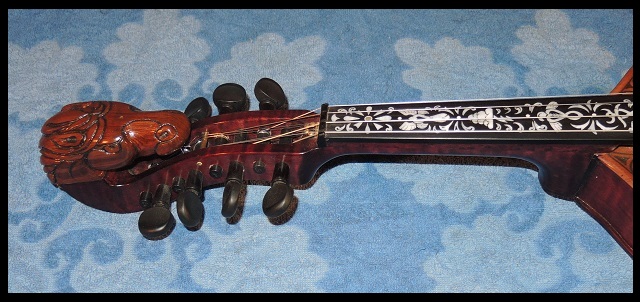
Each one has a theme: This one was inspired by the Jeffers Petroglyphs in Cottonwood County.
The top is carved from a piece of Redwood and the drawings were done with soft lead pencil.
And of course, to start it off with the center of the world. Everyone knows it rides on the back of a Great Turtle

The Horse head peghead is carved from a piece of Redwood.
It took me way too long to carve it,
so maybe that's why the horse turned out not looking too happy!
All 8 of the tuners are 'Knilling's Perfection Planetary Geared Tuning Pegs'.
These are a truly miraculous invention, and make tuning the strings so incredibly easy,
I'll NEVER use friction tuning pegs Ever again!!!
The neck, back and sides are made of
highly figured maple, and stained a nice
deep reddish brown
Merlot'.
The inlay on the fingerboard are carved from clam shells I found along the nearby
Watonwan River.
These designs are inspired from the rock carvings at Jeffers petroglyphs.
(From top to bottom)
The Sun above
and Great Spirit below.

A Thunder Storm is next,
with a Thunder Bird below
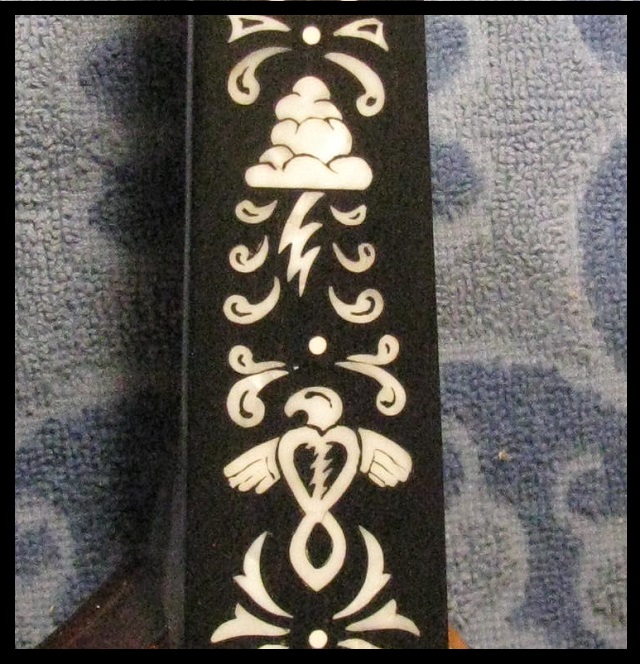
Next is a Shaman figure, falling leaf and a Snapping Turtle in the Cattails.
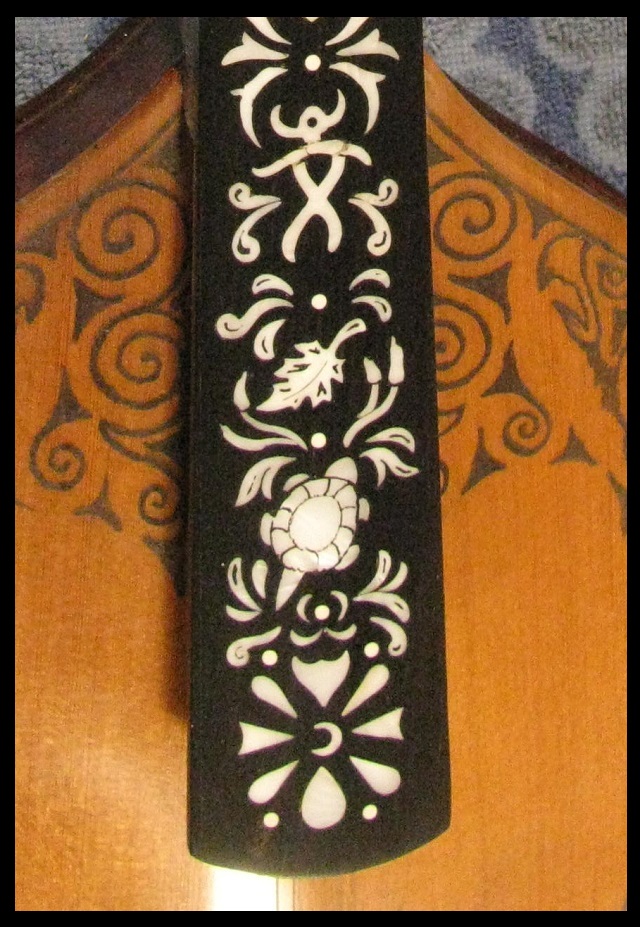
The designs along the edge of the top are drawn in with a soft lead pencil.
Here are two stylized Hawks in a somewhat 'Celtic' design, something extra I added in since I am certainly not Native American.
And of course, there just has to be Snakes, Plains Top Minnows and Bullheads included.
And the carved Buffalo Skull in the tailpiece
was a necessity too.
The 4 under-strings run under the hollow finger board. The nut is raised like a bridge for the strings to go underneath.
The 4 under-strings run through the bridge itself, between an open gap. This is a new design of my own making to make it much easier to change strings or adjust the bridge.
Right side view of the carved peg head
and tuners.
The case is made of carved Pine 2X4's and Plywood, all stained Merlot.
The inside of the case is padded with foam and blue felt, with two bow holders and a small hinged compartment box.
Currently not for sale.
I'm keeping this one.
___________________
Here's the Arpeggione.
___________________
For about 30 years now I've had an old dead headless Cello stashed away down in the basement, so last Winter I decided it was finally time to bring it back to life. I made a new head and neck, a fret board, new bridge and tailpiece. It wasn't as easy as I though it would be, but it worked!
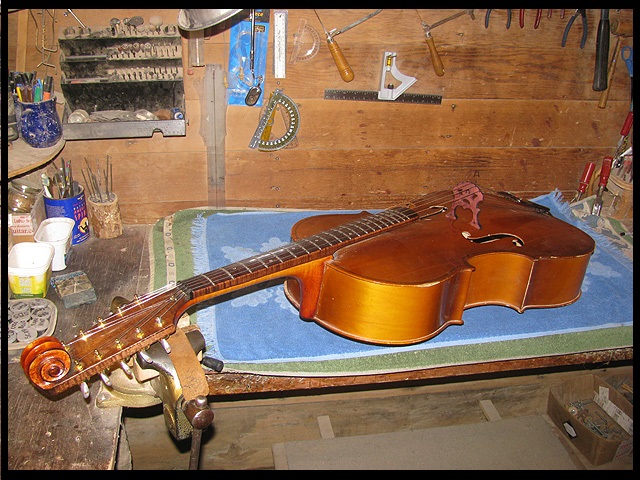
The face plate is stained Walnut brown.
The tuners are the same as I've been using for years now: Affordable but really top quality individual Guitar tuners.
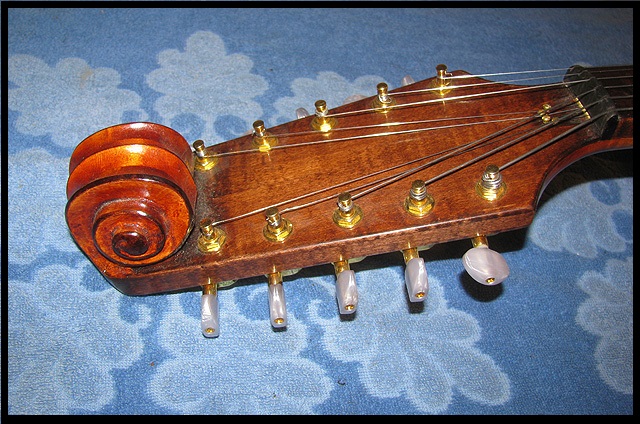
The fret board is made of
Hard Rock Curly Maple stained brown.
The radius is an outrageous 4 degrees (!) and yes you actually Can bend hard nickel medium sized Guitar frets that far.
(There 's a trick to it, but it can be done)
The top is made of 4 pieces of carved cedar or pine. (Herd to tell) But you can plainly see 3 distinct lines running thru it all.

The body was made in Chicago
and has several nicks and dings along the edges and it was apparently not a 'top-of-the-line' model, but it has a really surprisingly nice tone.
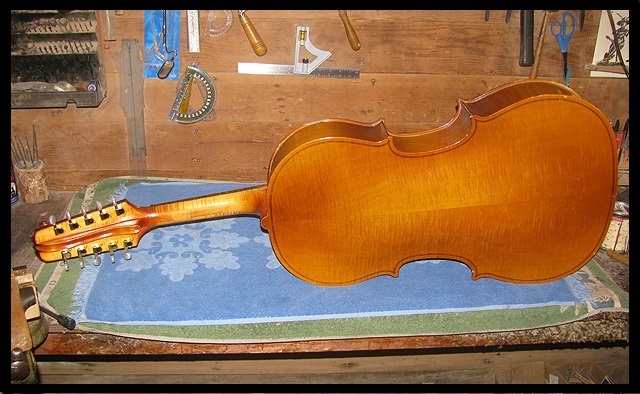
The head and neck are made of hard rock
Curly Maple.
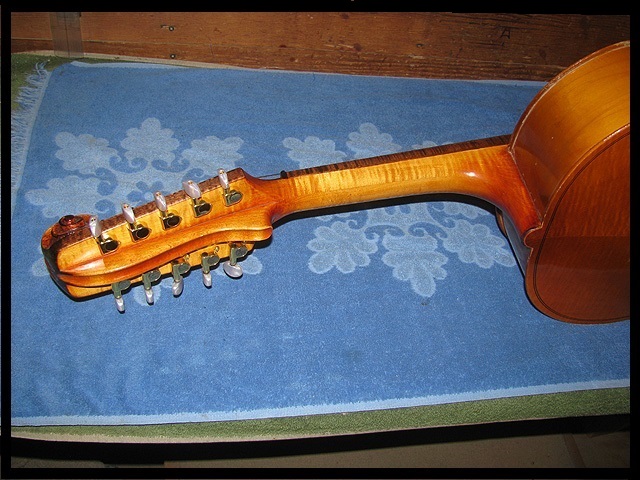
The back is made from 2 especially nice pieces of Curly Maple.
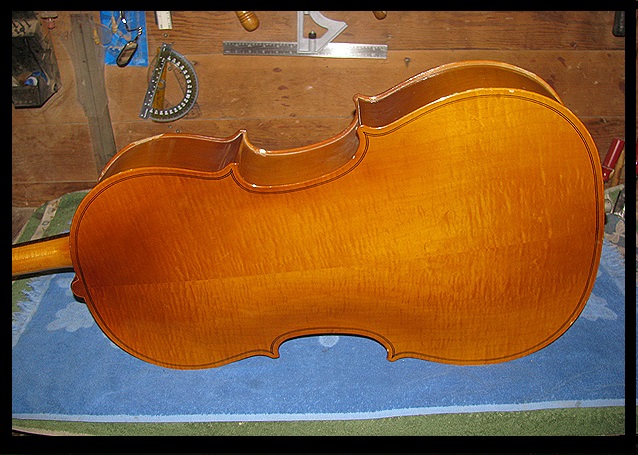
The nut is made of Ebony.
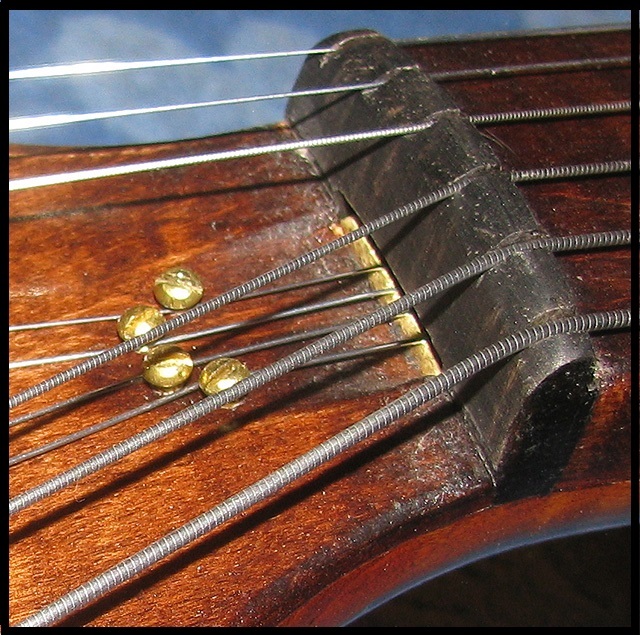
With 4 under-strings running under
the fret board.
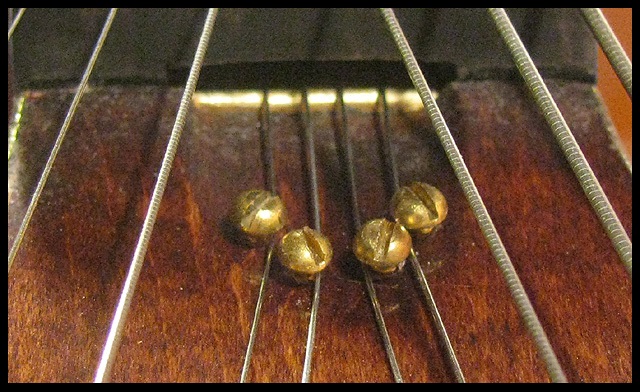
The bridge is made of Maple with 6 Ebony inserts under each top string, and has a new design for easy removal: Now the under-strings can simply be removed thru the gap in the lower part of the bridge.
No more re-stringing all of them to remove the bridge for maintenance or repair!
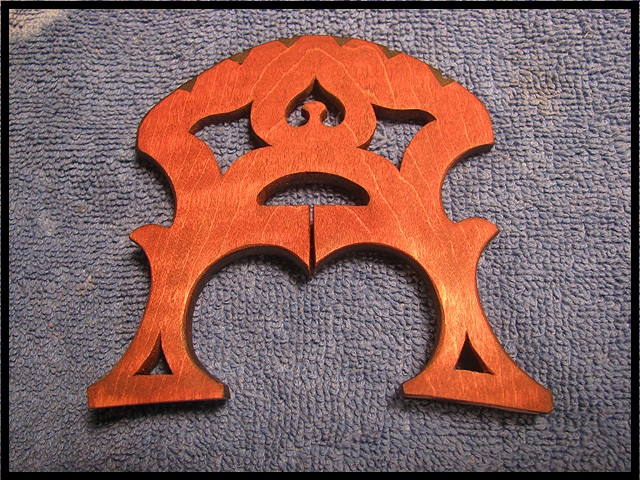
And it works too! The under-strings give off a nice resonant harmonic when the top strings are bowed or plucked.
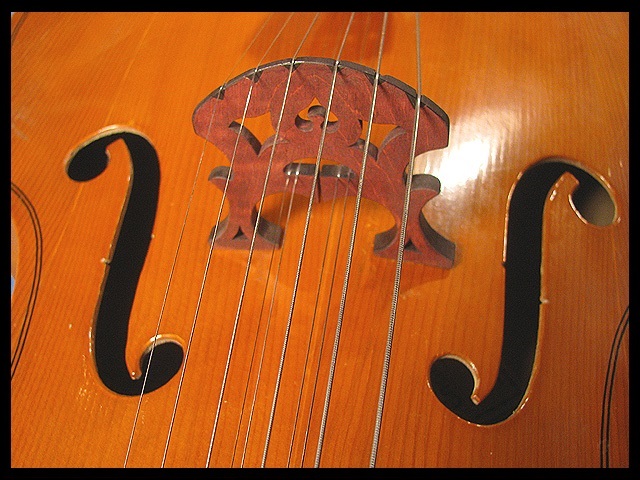
The Maple bridge is stained Merlot.
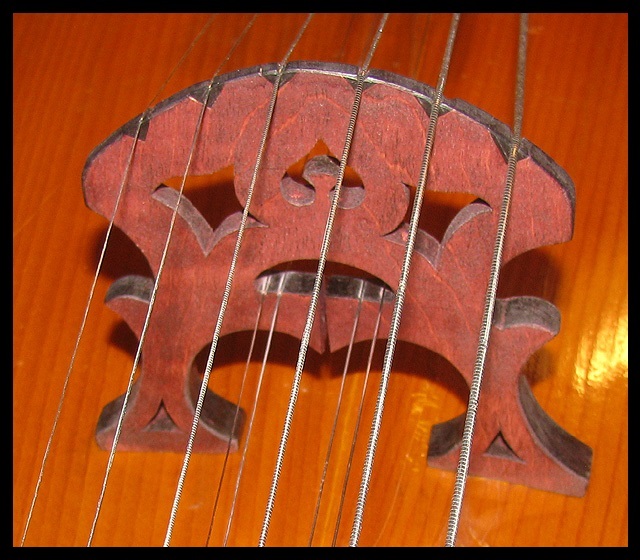
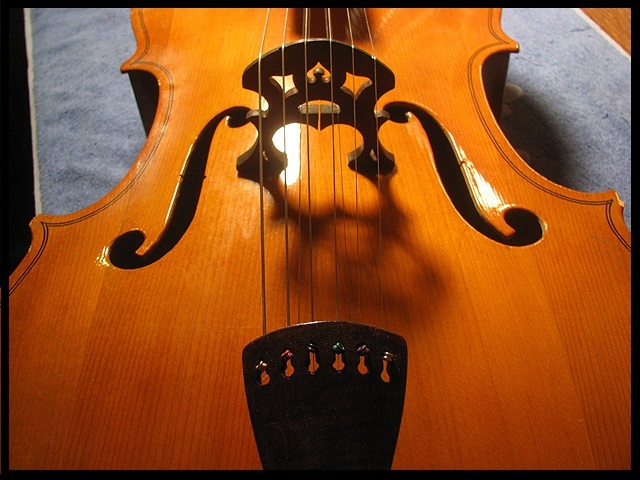
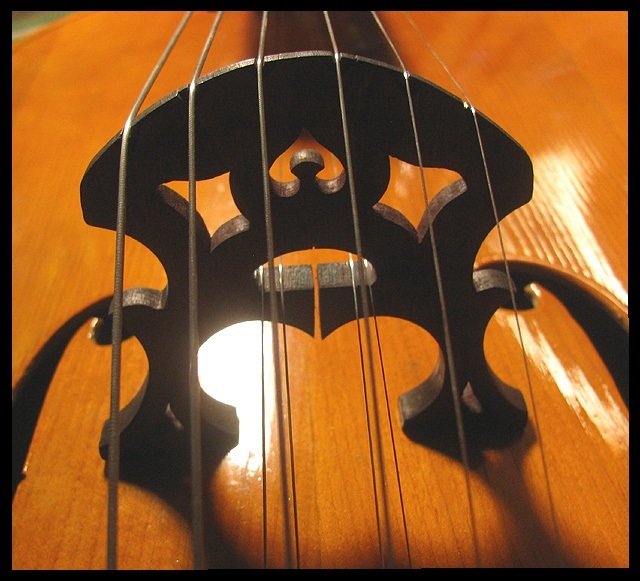
The tail piece is made of Curly Maple stained brown to match the fret board and head stock.
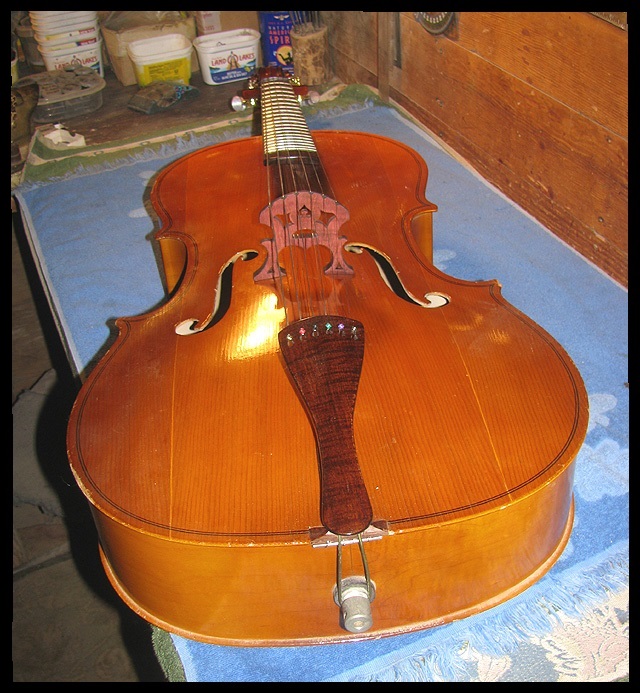
It is held on with a bent coat hanger.
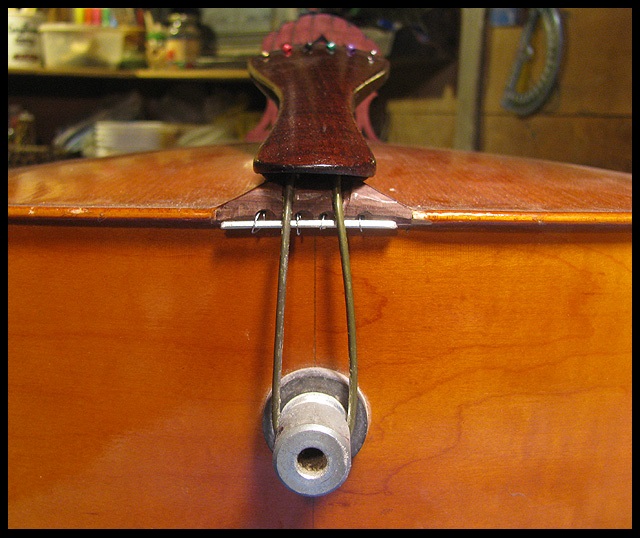
The 4 loop-end under-strings run thru the nut and are attached to a piece of fret wire.
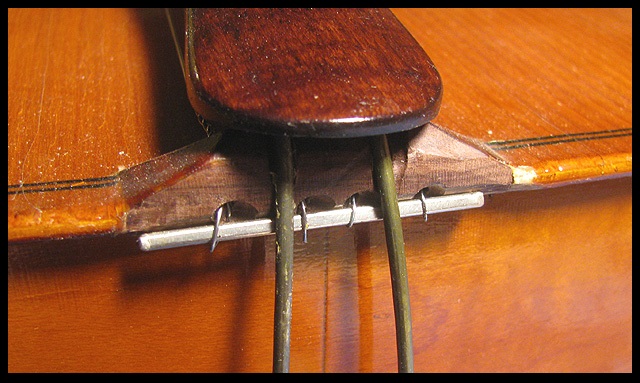
The strings are D'Addario Chromes
Electric Guitar strings
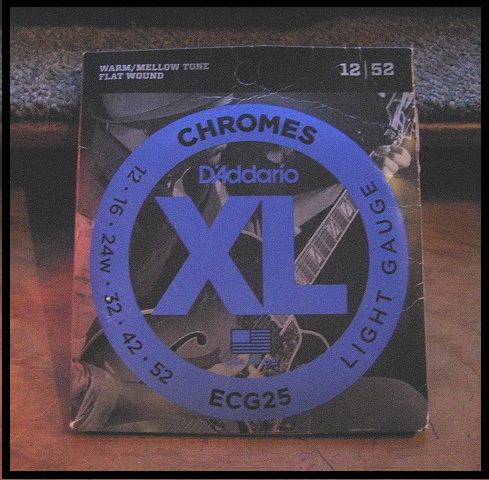
There is a price tag of
$1800
Now on display and for sale at
Groth Music in Bloomington, Minnesota.
____________________________
10 - String Viking Hardanger Viola.
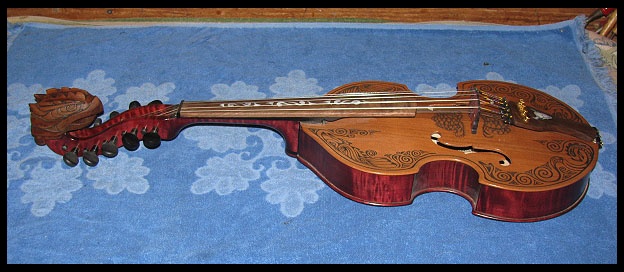
I made this a few years ago now, so it has had plenty of time to settle in.
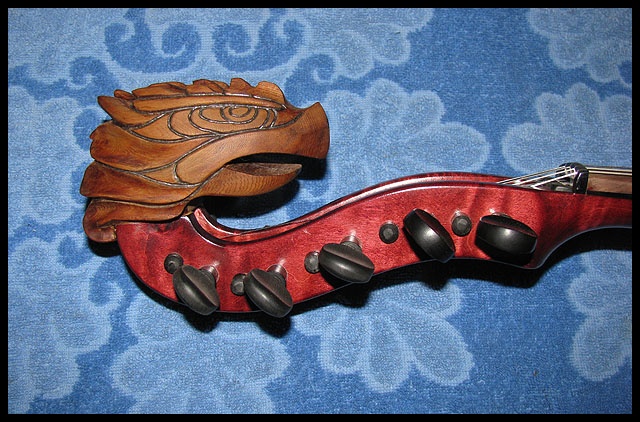
The carved Dragon figure-head is made of
Western Cedar.

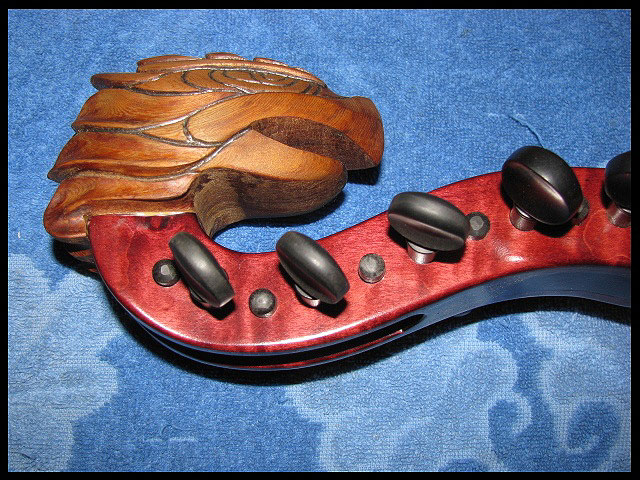
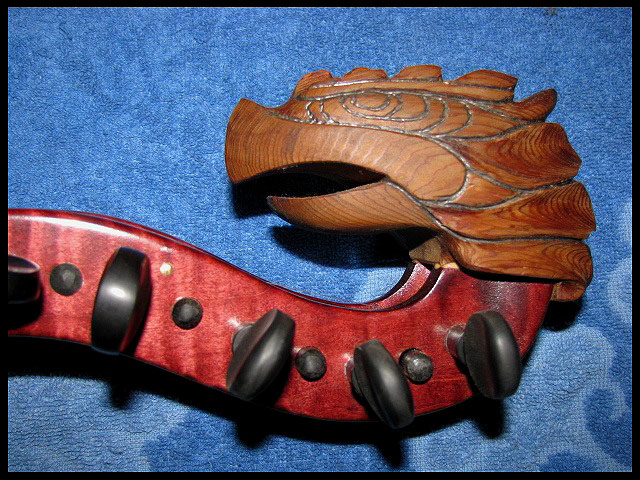
All of the tuners are Knilling Perfection Planetary Geared Viola Pegs.
(Which makes the tuning of the under-strings shockingly easy!)
l'll NEVER use friction tuners again!!!
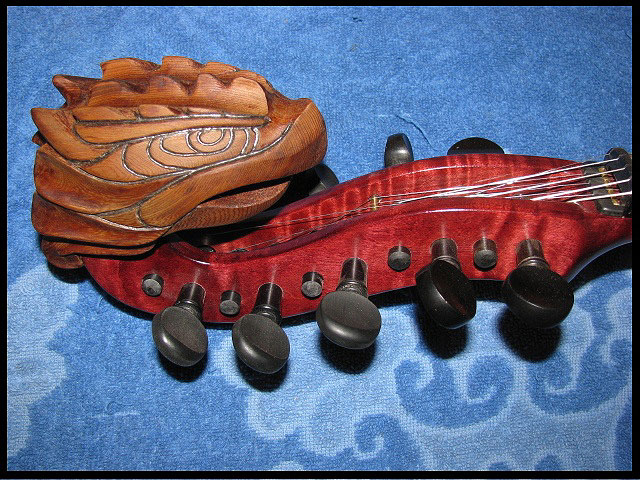
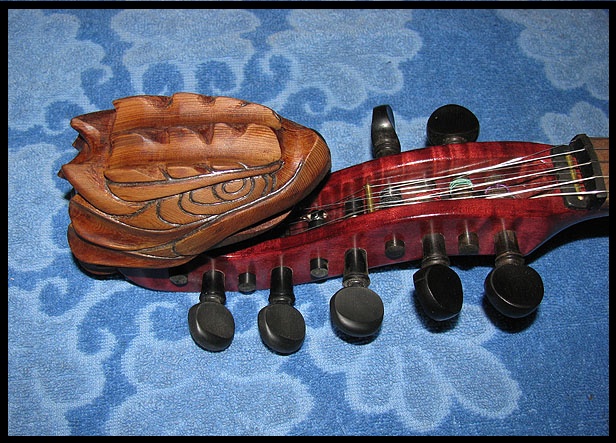
The inlay in the Walnut finger board is made of Clamshells from the Watonwan River.
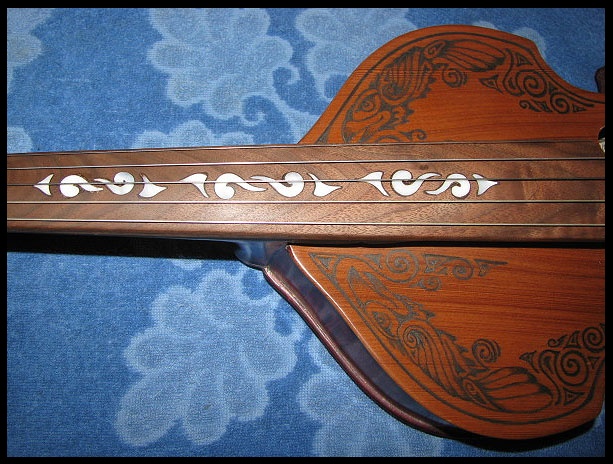
5 Bowed strings on top with
5 under-strings down below.
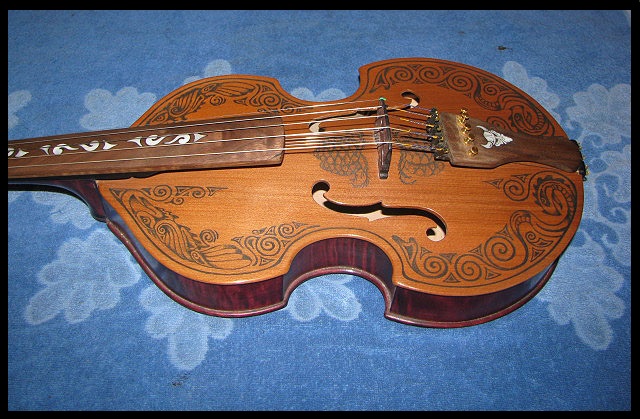
The Redwood top is decorated with Scandinavian designs in pencil.
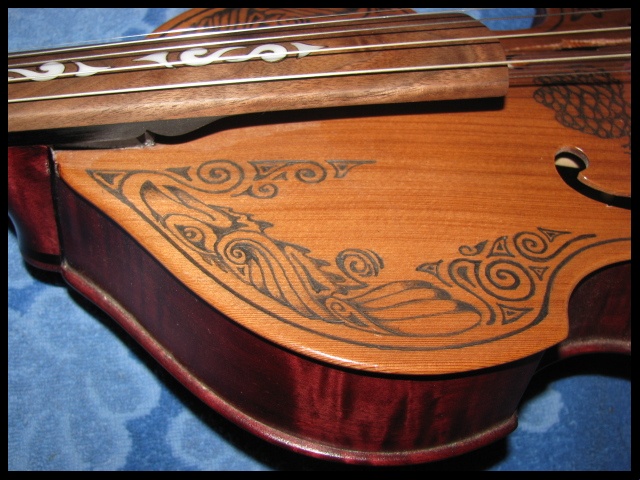
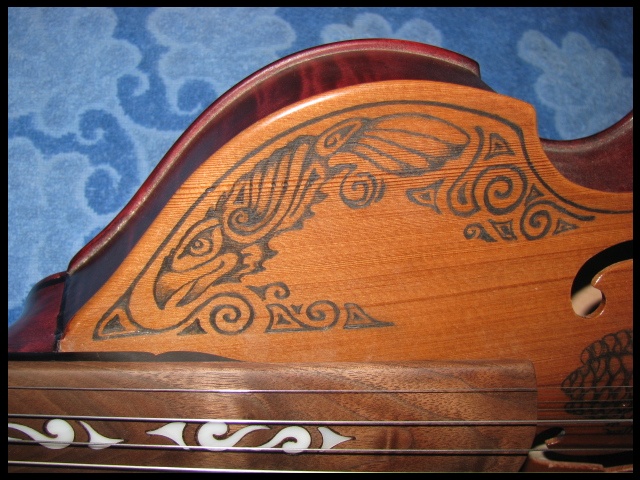
And of course includes Thor's two most famous Ravens: Hugin & Munin.
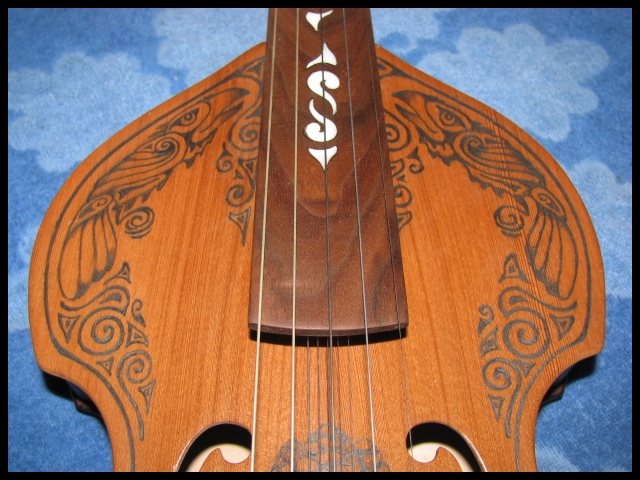
The Walnut tailpiece has a clamshell
Viking in between two Sea Dragons.
(Our grand child calls it the 'Viking Stormtrooper')
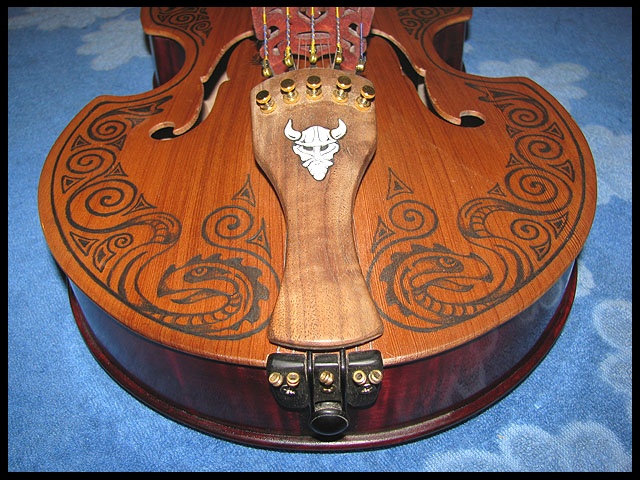
The ends of the understrings are attached directly to an Ebony block at the end of the body, thus relieving pressure on the tailpiece.
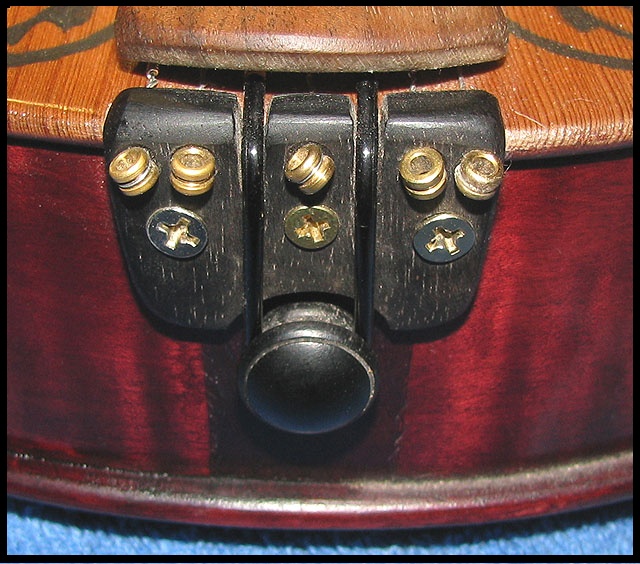
In the past, I've had some trouble with the bridge tilting forward over time, but I am pleased to report, that even after a year, this bridge is still as straight up and down as the day I strung it up!
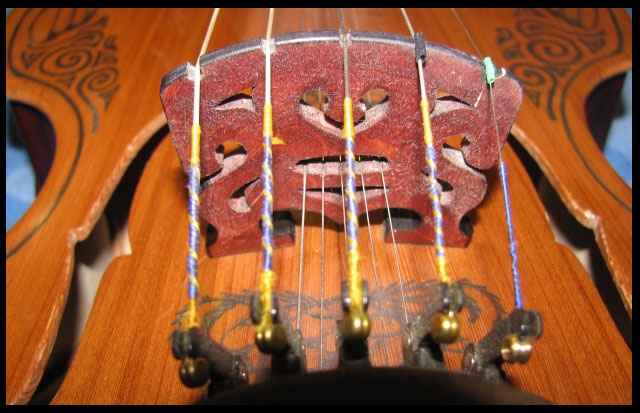
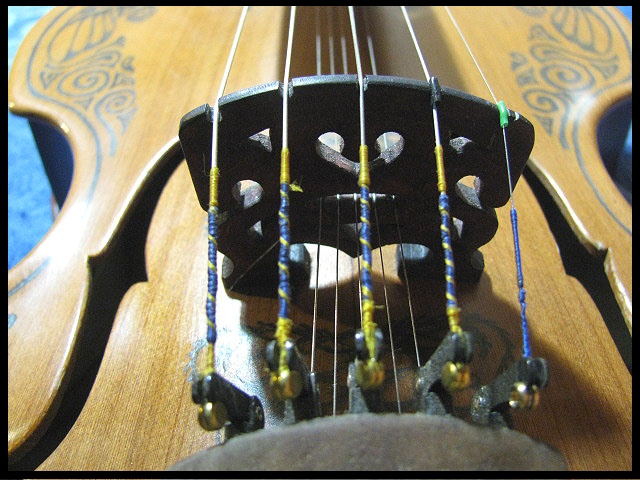
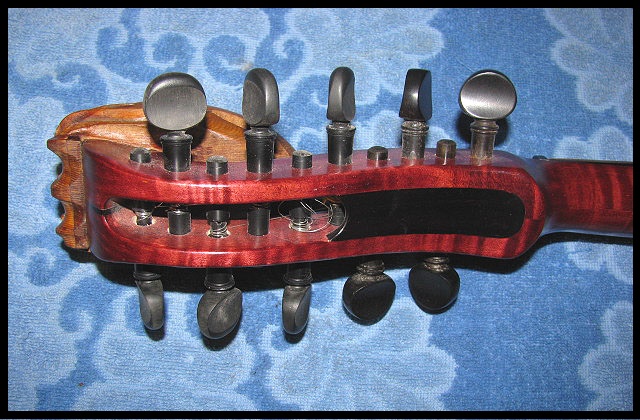
The peghead, neck, body and sides are made of highly figured Maple stained a nice deep burgundy wine colored Marlot.

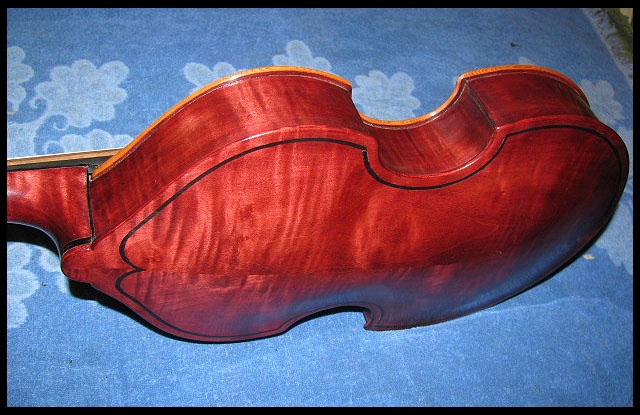
The depth of the side ribs are
1 - 3/4 inch deep.
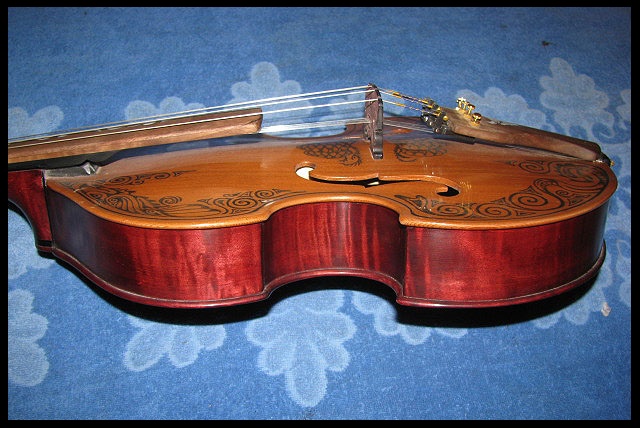
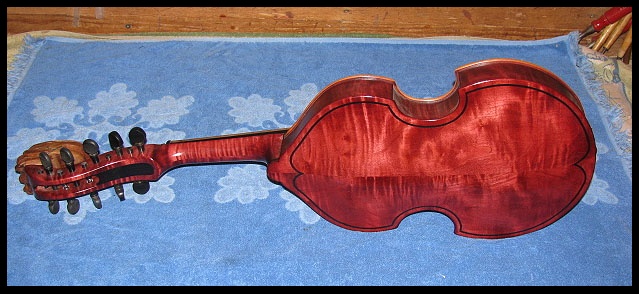

One thing you might want to know:
Because I used some fairly heavy hardwood for the inside neck and tail blocks,
The total weight of the instrument itself weighs
2 pounds 8.2 ounces.

The top and sides of the case are made of carved Pine 2x4's stained Merlot...
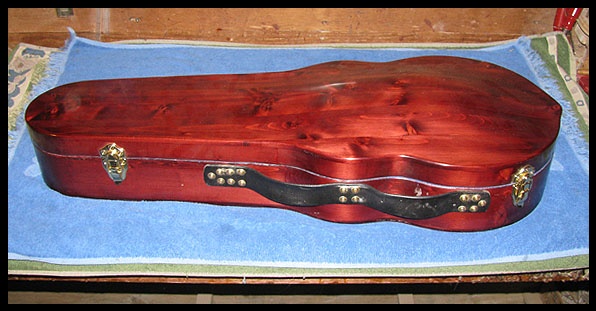
...with a Leather strap and brass
hinges and hardware.
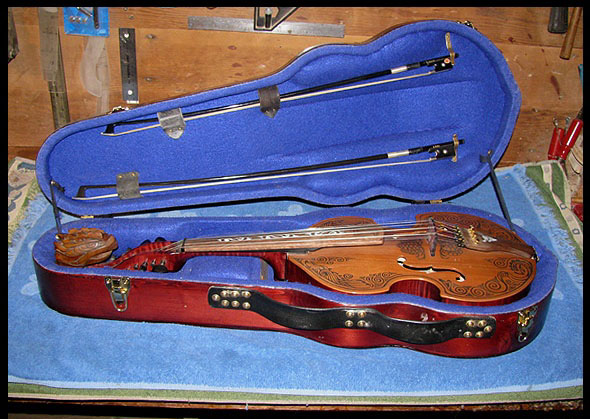
The inside is padded with foam and blue felt.
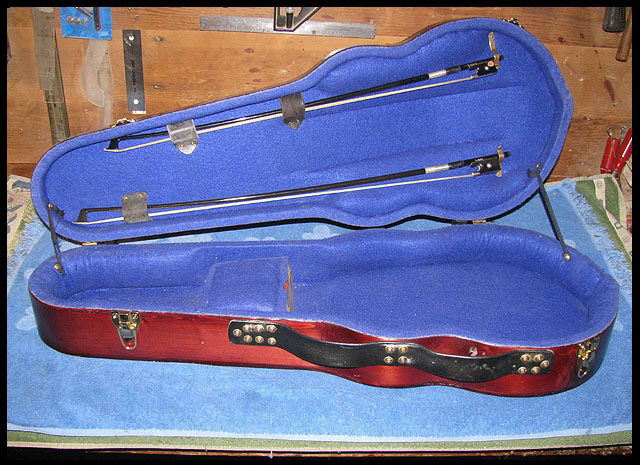
A small hinged compartment case
is included.
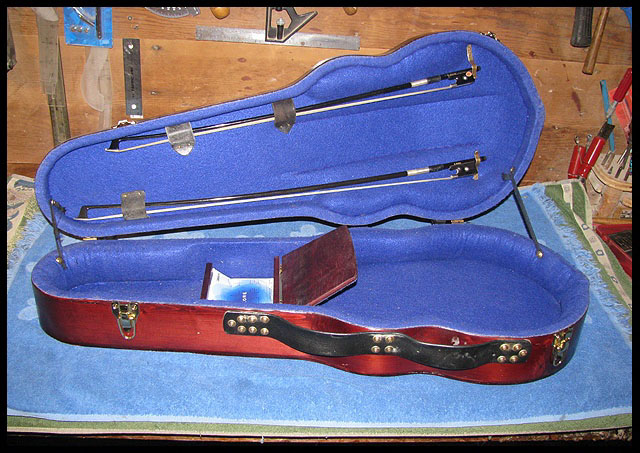
The back is made of a nice
piece of plywood.
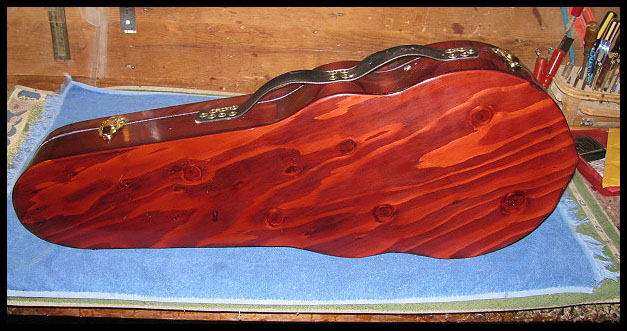
SOLD !!!
____________________________
The FiddleHarpa is also for sale!
(Scroll down the page a little way
for all the details)
___________________________
The Nyckelharpa (or "Keyed Fiddle") is the national folk
instrument of Sweden.
I made my first
Nyckelharpa in 1999 thanks to a grant from the
Prairie Lakes Regional Arts Council.
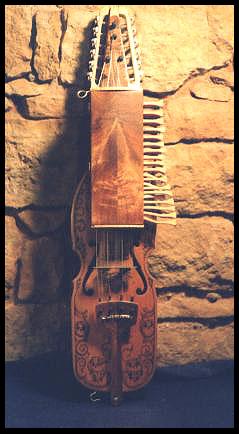
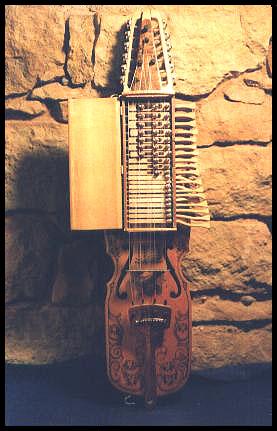
The design is based on the
blueprints from the book I bought from Soren Ahker.
I eagerly awaited the arrival of the original 1998
copy and was somewhat surprised (?) that the text
was printed in Swedish! A bit of a barrier that for
some reason I either didn't think about at the time
or simply knew that the numbers, measurements and
dimensions would be the same... which
thankfully they were.
(A few years later, this fine instruction manual was
printed in English but I have Yet to see a copy of
it!)
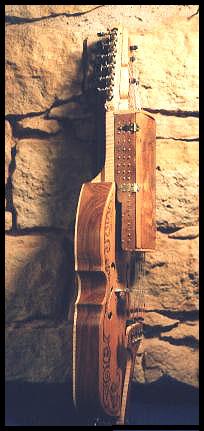
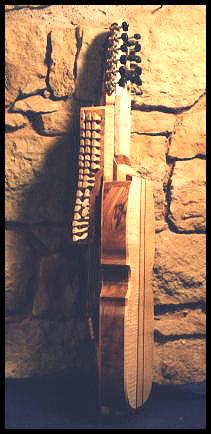
Anyway...This is how it turned
out. I was quite pleasantly surprised that it turned
out as well as it did. For at the time, I had never
seen one in person and certainly had Never played
one before.
_____________________
My
next project was to build a
Moraharpa.
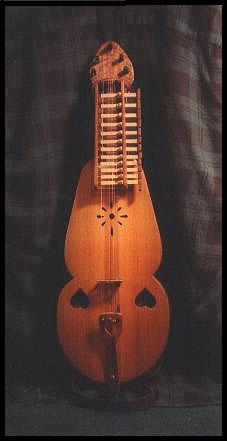
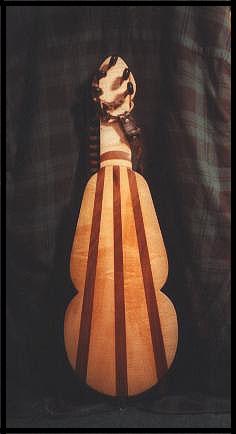
This
is the old medieval form (or ancient ancestor) of
the modern day Nyckelharpa. There is a stone carving
on a church in Gotland, Sweden.
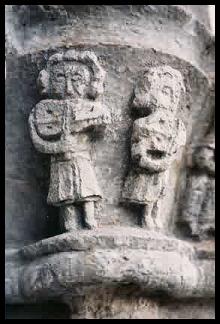
Below is an excerpt taken from the American
Nyckelharpa Association web-site:
The oldest
"evidence" of nyckelharpa use is a relief (left
picture) on one of the gates to Kallunge church on
Gotland from about 1350 depicting two nyckelharpa
players.
I built this one from
photographs off the internet. Its a very simple
design and also has a very limited playing range.
(It must have been more of an accompaniment to some
sad, droning vocal lament...so common in Medieval
Scandinavia)
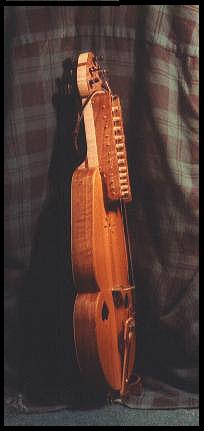
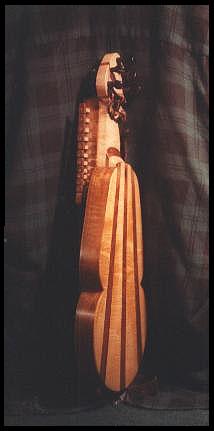
It
turned out real nice, too but it was like driving in
only one gear. A friend of mine, who is part of a
local Medieval reenactment group, bought this
one.
___________________________
My next attempt was to build a "Fiddleharpa". The standard size Nyckelharpa is tuned like
a Viola and I wanted something that could be tuned
and played like a Violin.
I experimented a little with the design, as
this one has a carved arched top and back. I have
found that this didn't necessarily add to the sound
of the instrument, as the first one I made (with a
flat top and back) actually sounded better! I also
added in a 4th row of keys for the 'G' string. (This
was apparently nearly un-heard of at the time, as I
recall very few builders had tried this) Times have
changed though and it is now quite common to see
several different varieties and experimentation
going on with the making of these instruments.
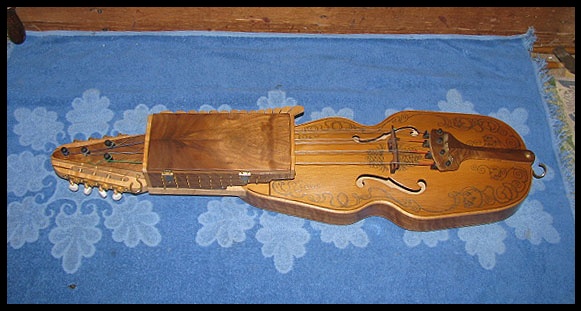
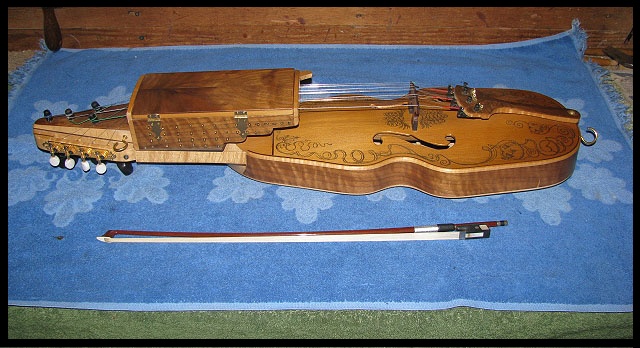
Made of highly figured Maple for the back, neck and keys. Walnut for the sides, tailpiece, peg box and top lid.
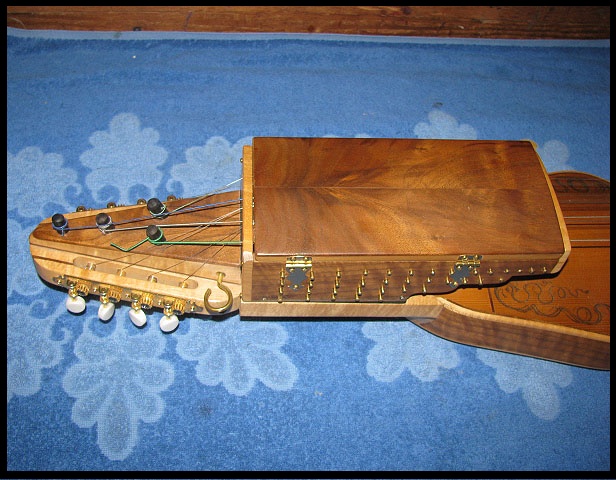
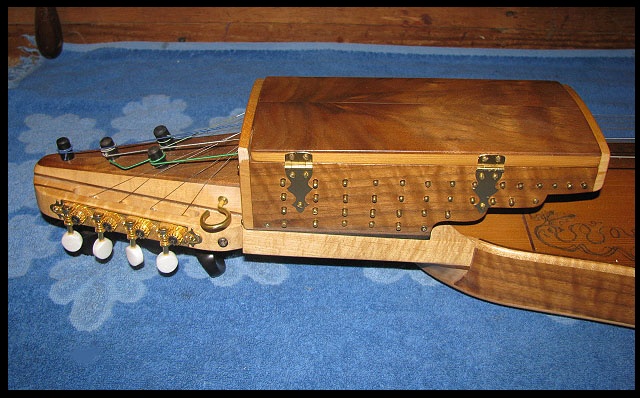
The
soundboard is made of Western Cedar and is adorned
with an intricate grapevine design in soft lead
pencil.
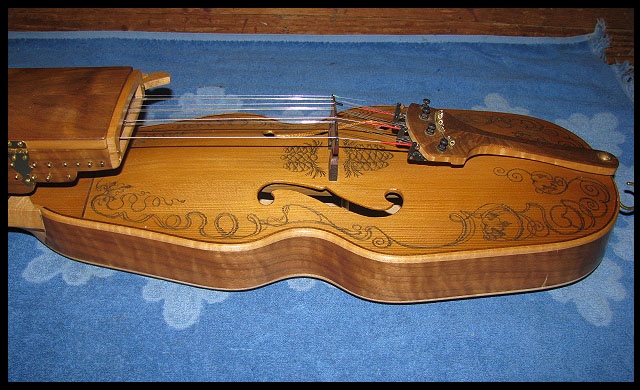
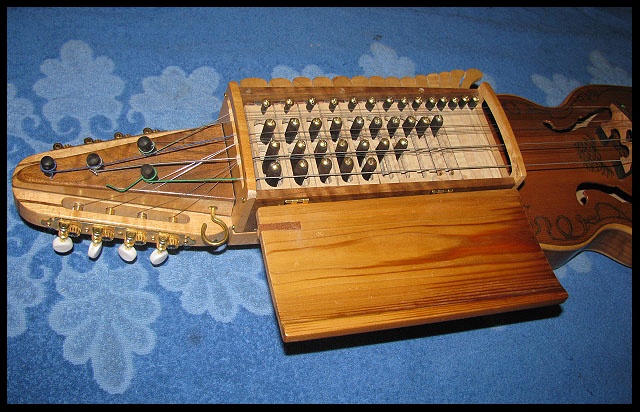
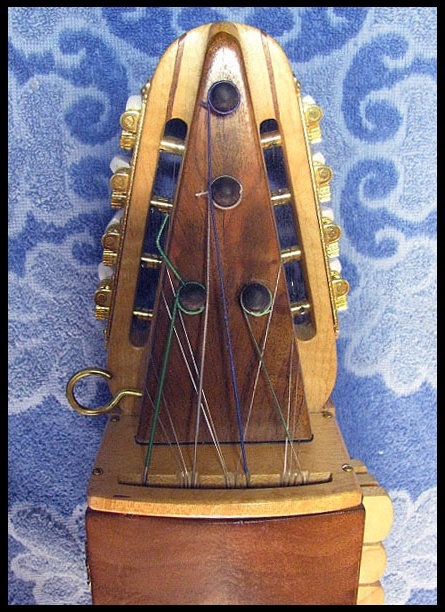
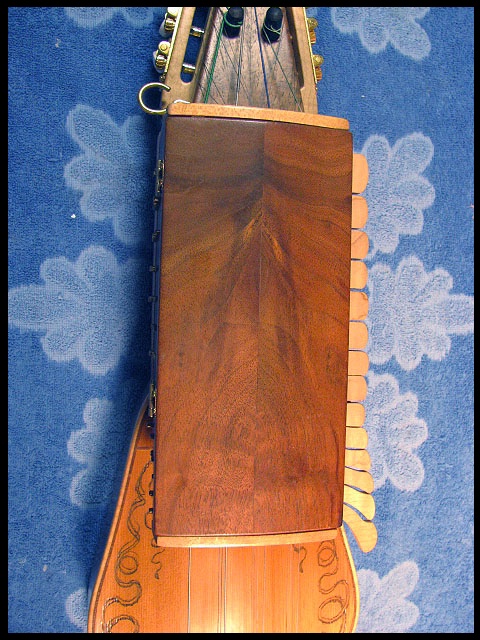
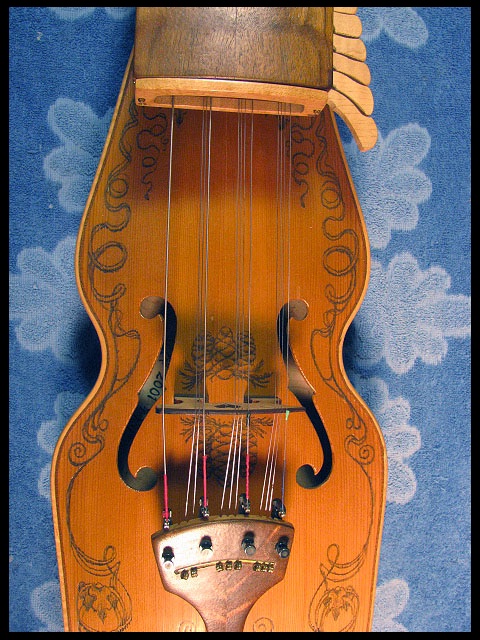
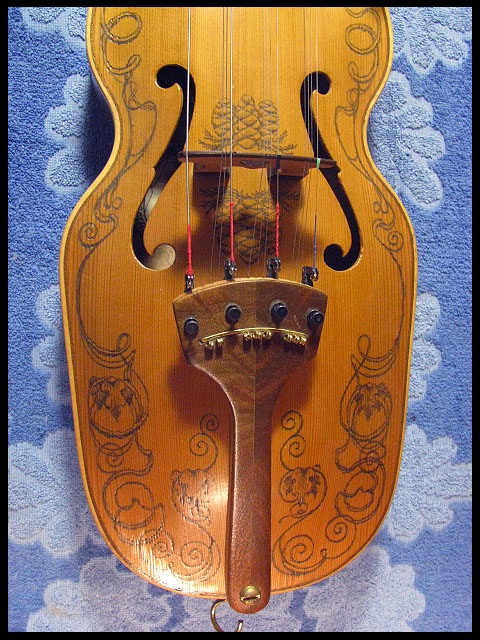
Each key is attached to the left side peg box by little brass rods that are easily visible when you press in a key. This makes it easier to see where you are with the lid down.
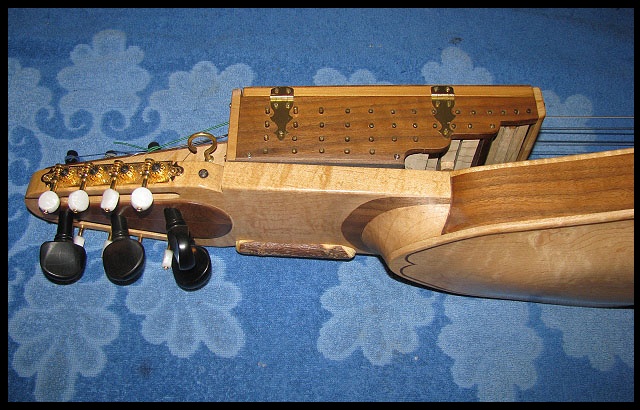
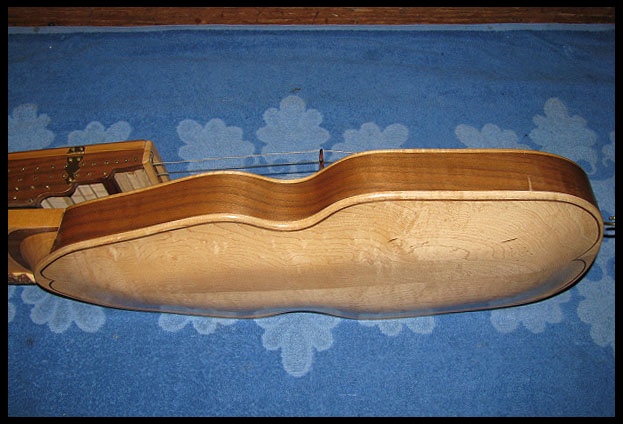
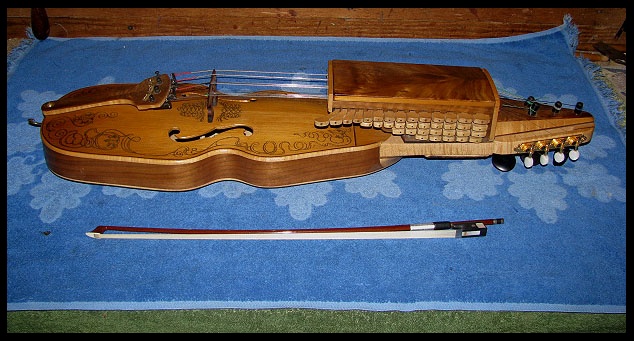
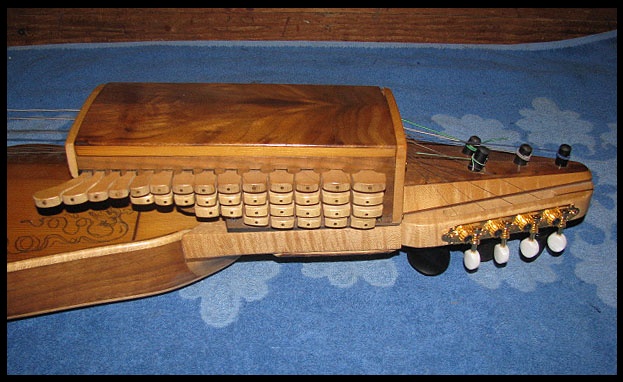
The keys are rounded to make it easier to slide up and down the scale. The lid is a non-traditional addition that can easily be removed if it gets in the way of seeing the moving keys.
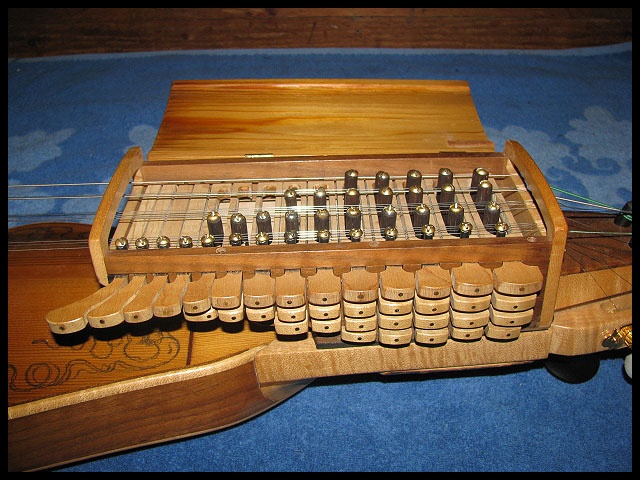
The 'E' string tangents are made of pieces of oblong aluminum rods (actually model airplane parts) It was an experiment that worked. The rest are pieces of Cherry wood stained black.
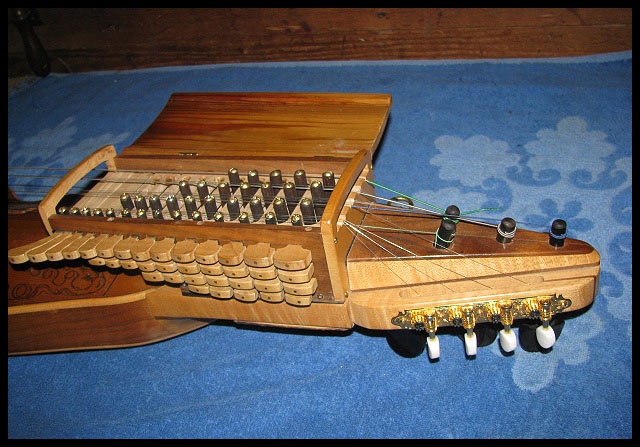
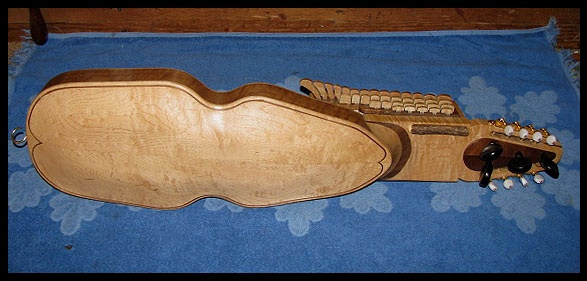
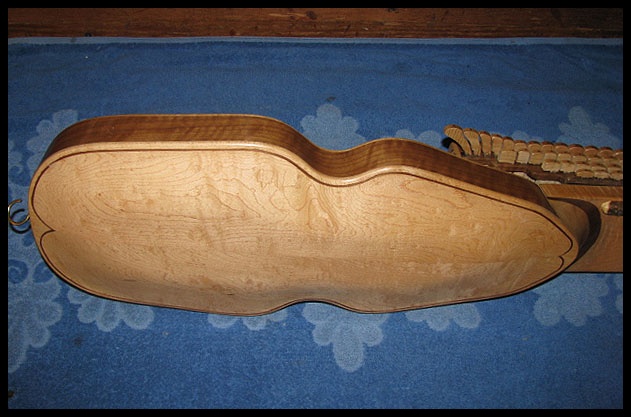
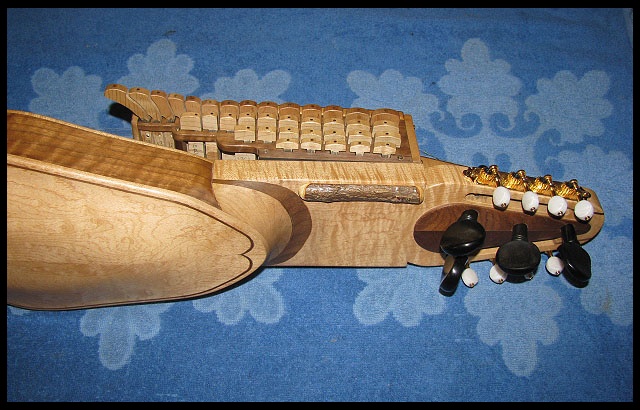
4
Ebony 1/8 size Cello tuners for the main strings and
a set of Gotoh Mandolin tuners for the under
strings. (I added in a piece of tree branch as a
thumb rest) Scale length, from nut to bridge, is 14
inches.
(About the same scale length as a Mandolin)
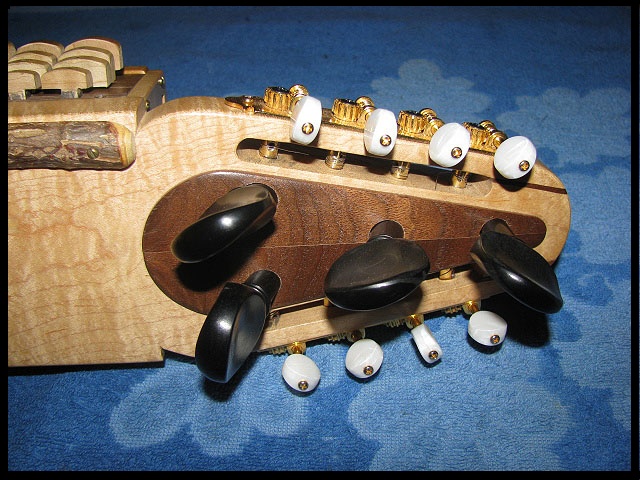
The
case is made of Pine and Plywood and is padded with
foam
and lined with felt.
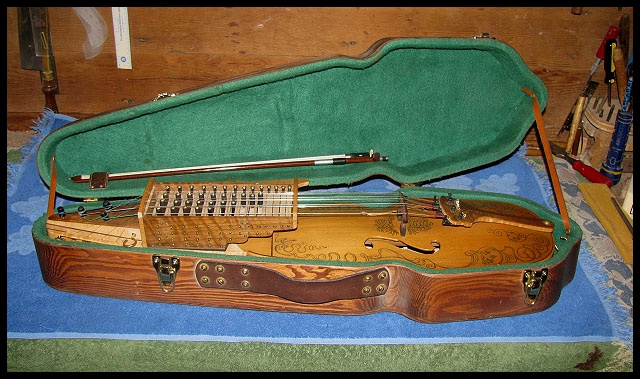
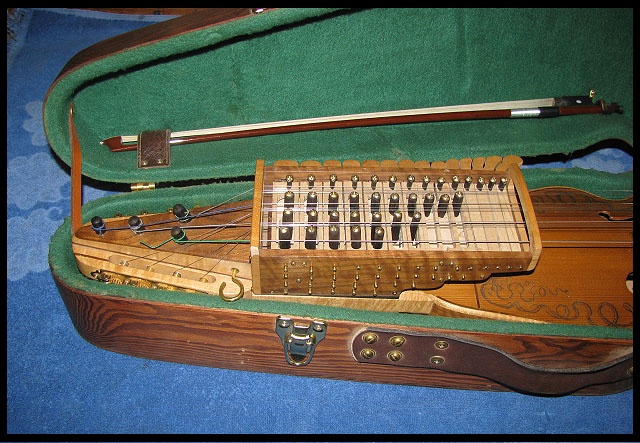
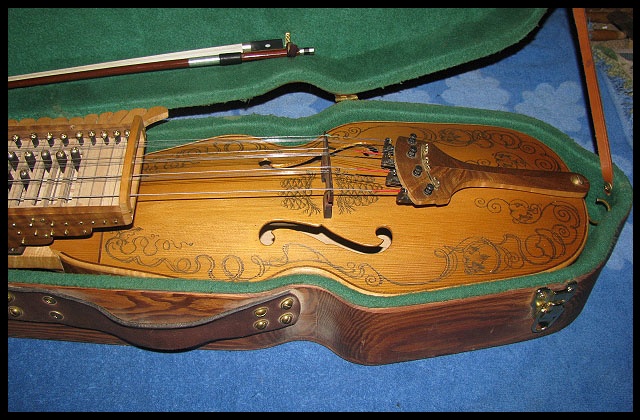
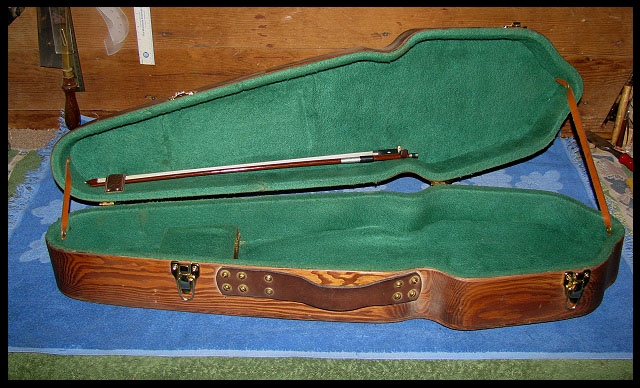
There is a small storage compartment with a lid. A half-size Violin bow an a leather strap is included.
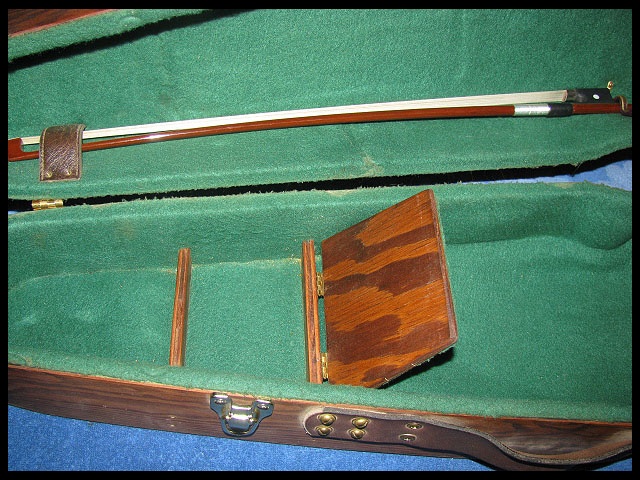
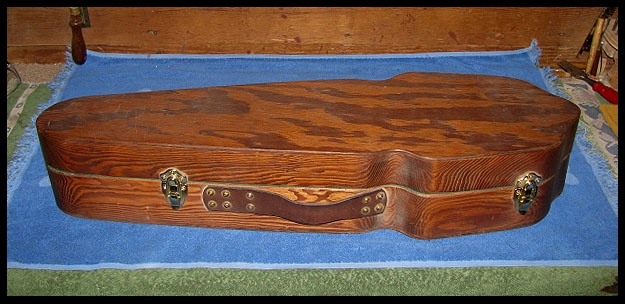
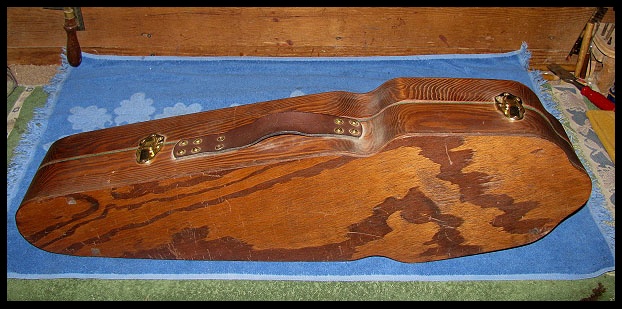
The back of the case will have 4 black rubber furniture bumpers, as soon as I get them installed.
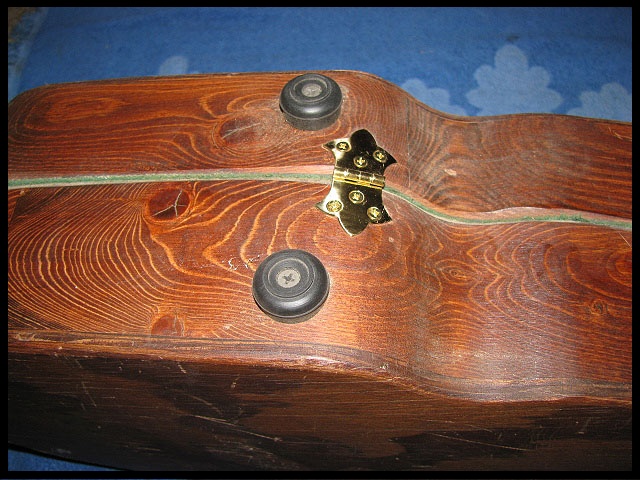
The
lower side of the case has rubber furniture bumpers
to keep the hinges from scratching up the furniture
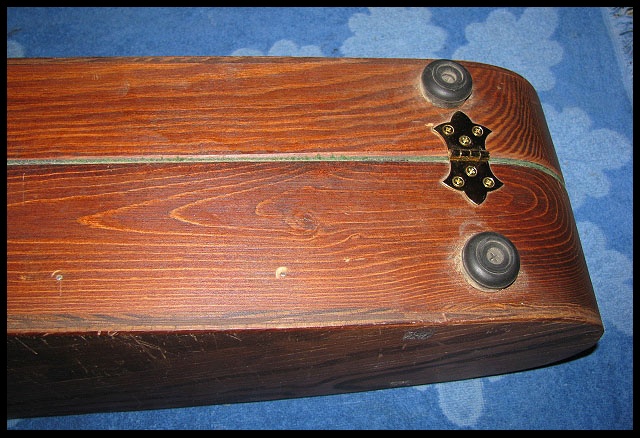
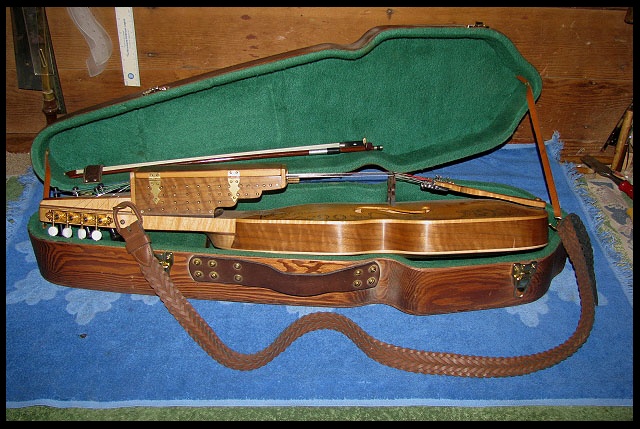
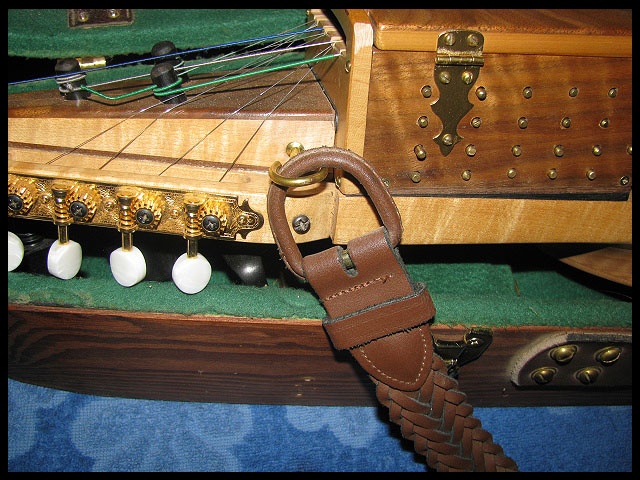
Nice soft braided leather belt for the strap.
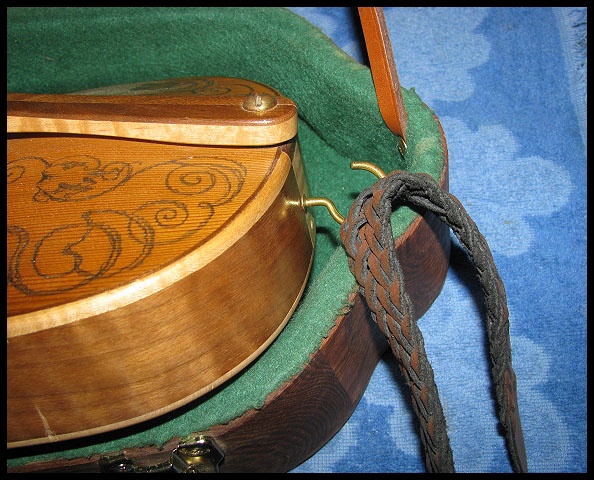
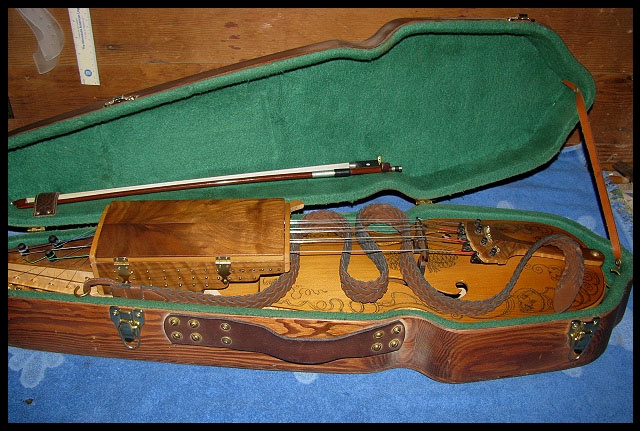

Here's something you'll
probably want to know:
Over the years, I've actually
had to re-build this thing twice. Over time, the
pressure of the strings (and a less than solid neck
joint) has caused the 'Harpa to bow up until it
looked like a Swedish Cod Boat! The solution to this
was to re-angle the peg box, raise the bridge and
re-align the strings with the tangents. I've done
this twice now, and I'm positive it has 'settled'
and bowed up about as much as it can.
You can see by the blue line
down below that the line between the nose and the
tail is not perfectly straight, but ever so slightly
bowed. This will not affect the sound or playability
of the instrument. It's just one of the unique and
quirky
things about it that makes it special.

________________________________________________
I did have a price tag of
$2400.
on it...
But
now I'm thinking of keeping this one too.
(Includes case, bow,
leather strap and rosin)
_____________________________________________
All products Shop Cat
tested and approved!
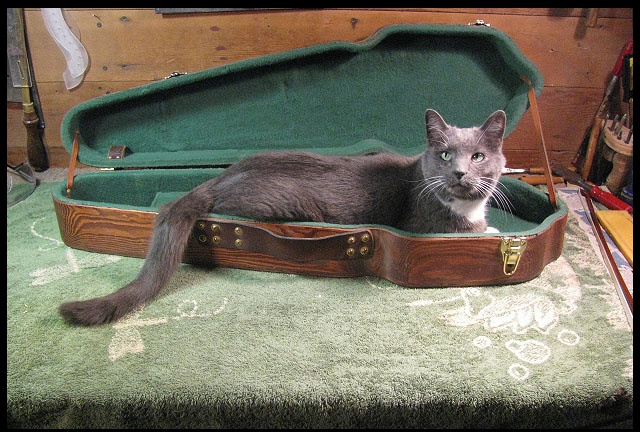
(Shop Cat not included)